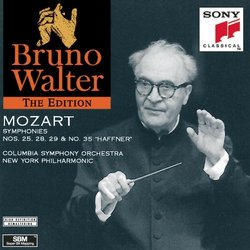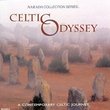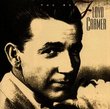| All Artists: Wolfgang Amadeus Mozart, Bruno Walter, Columbia Symphony Orchestra, New York Philharmonic Title: Mozart: Symphonies Nos. 25, 28, 29 & 35 Members Wishing: 0 Total Copies: 0 Label: Sony Release Date: 10/31/1995 Genre: Classical Styles: Historical Periods, Classical (c.1770-1830), Modern, 20th, & 21st Century, Symphonies Number of Discs: 1 SwapaCD Credits: 1 UPC: 074646447321 |
Search - Wolfgang Amadeus Mozart, Bruno Walter, Columbia Symphony Orchestra :: Mozart: Symphonies Nos. 25, 28, 29 & 35
 | Wolfgang Amadeus Mozart, Bruno Walter, Columbia Symphony Orchestra Mozart: Symphonies Nos. 25, 28, 29 & 35 Genre: Classical
For an entire generation of Mozart lovers, Walter's interpretations were the ultimate in sophistication and elegance, and so they remain. They still sound totally natural and inevitable, with a breadth of phrasing and very... more » |
Larger Image |
CD DetailsSynopsis
Amazon.com For an entire generation of Mozart lovers, Walter's interpretations were the ultimate in sophistication and elegance, and so they remain. They still sound totally natural and inevitable, with a breadth of phrasing and very human warmth that points up the vocal nature of Mozart's melodic inspiration. Although the mono sound has dated, these performances are like old friends, and you'll welcome them in your collection. --David Hurwitz Similarly Requested CDs
|
CD ReviewsVintage Mozart! niveditahr | CHENNAI,INDIA | 07/27/2002 (4 out of 5 stars) "Despite the poor rating by a few of other reviewers I went ahead and bought this GEM.These are quite simply among the finest performances of these delightful symphonies.The sound quality,being a mono recording,is below par(that is why 4 stars)but still is quite serviceable.Now let us come to the performances-Symphony no25 opens enegetically with a nice rhythmic thrust and dash and the strings are outstanding.The slow movement that follows is a caressing reverie with a tinge of regret beautifully shaped.the third movement,a minuet starts on a bright note with the strings playing a nice rhthmic Theme leading to a celestial Oboe theme taken up by the woodwinds.The Legendary Walter's signature is quite in evidence,in that he does not miss to point to some of these inner voices which would normally get drowned in other breezy performances by lesser conductors.The final movement is given a good thrust and the Symphony comes to a triumphant finish. The other symphonies (nos 28,29 and 35)are simply outstanding.I need not go into their virtues.Suffice it to say that Bruno walter was one of the greatest conductors of Mozart,besides Karl Bohm and Peter Maag.I also wish to draw attention to the other Great Performances of Bruno Walter of the Mozart Symphonies nos 36and 38,39,40,41.Also listen to Walter's Eine Kleine Nacht Music and other overtures.They are all peerless readings.Just what is so special about them?I will quote the Great Maestro"My task in performing Mozart had become clear to me:Every characteristic and truthful detail must be given powerful dramatic expression without impairing the vocal and orchestral beauty.This beauty permitted no exaggeration in Dynamics and Tempo....The problem therefore consisted in achieving all fulness of expression within the limits prescribed by beauty and in resolutely filling that beauty with musical and Dramatic Power without putting an earthly burden upon its unearthly lightness". I have other recordings of these pieces ,some of the modern recordings including Barry Wordsworth(Very Good performances)on the Naxos Label.Yet Walter's Mozart has a magic all its own and that is what plays on my CD player most of the time! I strongly recommend that you give yourself a Nice Treat!" Definitive Reading. Some reservations though. niveditahr | 02/07/2002 (4 out of 5 stars) "For the listener accustomed to Bruno Walter's CBS/Sony recordings, the sonic qualities of this disc may disappoint. These recordings, made in New York some 7-8 years before Walter's landmark recordings with the Columbia Symphony Orchestra in Hollywood, are not up to the same recording quality of the later discs. On interprative grounds these recordings are worthy of note for the serious collector of Mozart or Bruno Walter recordings. Walter's approach is distinctive and these recordings would complement other definitive readings of these works such as Mackerras/Prague CO, or Karajan/VPO (No. 35), or Szell/Cleveland (No. 35). The mono recordings, though not as warm as they could be, offer an ample sound and good detail.Finally you get four symphonies on one disc. The repeats are not followed (a fact of life for many LP-era recordings). Yet no other offering on the market gives you these four symphonies, on one disc, at mid-price: a real boon for serious collectors." Magnificent Mozart that helps set Walter's reputation straig John Grabowski | USA | 02/26/2006 (5 out of 5 stars) "Bruno Walter is of course the conductor of genteel Mozart, with thick billowing clouds of sound and a large rotund character. Don't look for depth in Walter; look for the jovial character of easy Viennese living. For the guts and grit, you have to go to HIP performances, because they dig under the grace and get to the fire, right? Right?
Well, like many myths, this one is debunked when one looks a little deeper. Actually, you don't have to look much deeper at all. This recording alone should persuade anyone that Walter could deliver deeper, more demonic Mozart than is commonly believed. This is because most of Walter's recordings known to us today are from his stereo period, right before he died. Indeed in his last years he was mellower and less spontaneous. But in these and other earlier readings, we have a door to a Walter many people today aren't familiar with--slashing accents, brisk tempi, a sound that, while certainly not thin, is lithe and agile. Just listen to the opening movement of No. 29, for example--the strings practically leap up and down with excitement, and the phrasing is supple and animated in a way you rarely hear today--the Columbia Symphony Orchestra practically sounds Viennese! Slow movements in this set are deep and serene, with a naturalness of phrasing modern ensembles can't match. More noteworthy, however, is the dark side in many of these recordings, such as the "little" G minor symphony. This is not the type of temperment you'd expect from the genial old man we've all come to know, but it was there. And who cares if these recordings are "correct" or not. Today's scholarship will change in 40 years too, and many of today's Gardiner and Hogwood recordings will be looked upon as relics someday. Sony has made things a bit confusing here. Over time they have released both Walter's later stereo Columbia Mozart readings and these earlier mono recordings, several different ways. You may think you already have "these" recordings, only to find you have one set but not the other. If I could have only one, it would be the earlier, mono recordings. Sure the sound isn't quite as good (though it's very good in general) and sure, repeats are skipped--repeat-skipping was the norm of the day. Of the later stereo recordings, only No. 35 compares with, and probably even surpasses, this reading for grandeur and nobility. There are other Sony recordings in this series of Walter's mono Mozart symphonies, including one fascinating disc where he rehearses the entire Linz symphony bar for bar. I highly recommend them all. But if you are confronted with a choice between these mono performances and the later stereo recordings in better sound (and not all that much better, actually, save they are in stereo), I'd recommend you choose these in a heartbeat. And be prepared for some passionate Mozart playing you rarely hear in this Mozart-is-good-for-your-brain age." |

 Track Listings (16) - Disc #1
Track Listings (16) - Disc #1








